Lobsters and Crayfish, both intriguing crustaceans, are distinct in many ways.
Lobsters, primarily marine dwellers, have long bodies and are found in oceans worldwide. They are commercially significant and often considered a delicacy. On the other hand, crayfish are freshwater creatures that are smaller in size and mostly inhabit rivers, lakes, and streams. Their segmented bodies and habitat preferences are quite different from those of their lobster cousins.
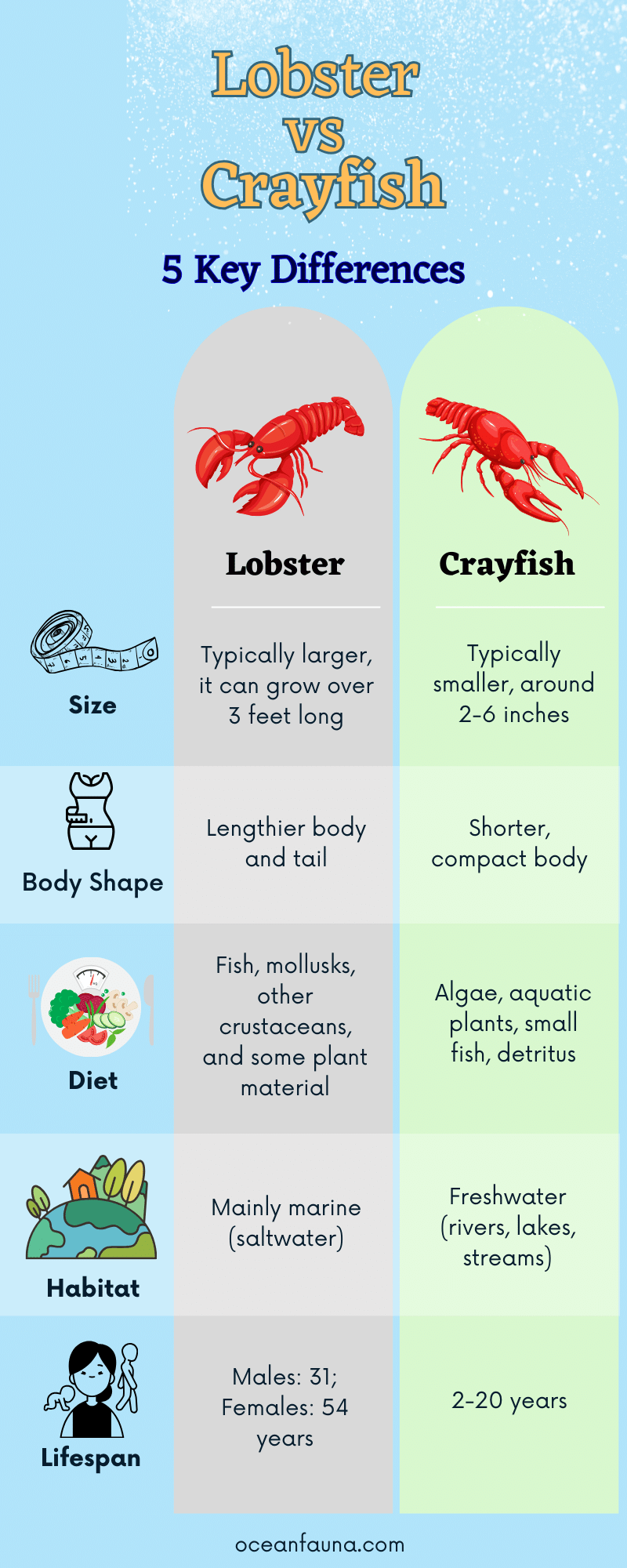
While both lobsters and crayfish share a common ancestry, their evolutionary paths have taken them to different corners of the aquatic world. Dive deeper as we journey through the intriguing contrasts between lobsters and crayfish.
Lobster vs Crayfish – A Quick Comparison
| Feature | Lobster | Crayfish |
| Body Shape | Lengthier body and tail | Shorter, compact body |
| Size | Typically larger, it can grow over 3 feet long | Typically smaller, around 2-6 inches |
| Habitat | Mainly marine (saltwater) | Freshwater (rivers, lakes, streams) |
| Diet | Fish, mollusks, other crustaceans, and some plant material | Algae, aquatic plants, small fish, detritus |
| Social Behavior | Mostly solitary but can form groups during migrations | Typically solitary, territorial |
| Antennae | Two long primary antennae | Two shorter primary antennae |
| Claws | Usually, there are two large claws: one for crushing & one for cutting | Typically, two, but smaller than a lobster’s |
| Number of legs | 10 (including claws) | 10 (including claws) |
| Coloration | Varies, but often greenish-blue to brown | Often brown, green, or blue |
| Reproduction | External fertilization | Mostly internal fertilization |
| Lifespan | Males: 31; Females: 54 years | 2-20 years |
| Edibility | Commonly consumed, especially in culinary dishes | Eaten in some regions, less common than lobster |
Lobster vs Crayfish – What Are the Key Differences?
Lobsters and crayfish are both members of the crustacean family. Both are bottom dwellers who love to creep under rocks and crevices on the muddy bottoms.
They have similar appearances that might make one assume they’re nearly identical. However, these crustaceans have evolved distinct characteristics tailored to their unique habitats and lifestyles.
So, let’s plunge into the depths of their world and uncover how lobsters and crayfish differ.
1. Taxonomy and Scientific Classification
Lobsters and crayfish share the same class and order but diverge at the family and genus levels.
Lobster
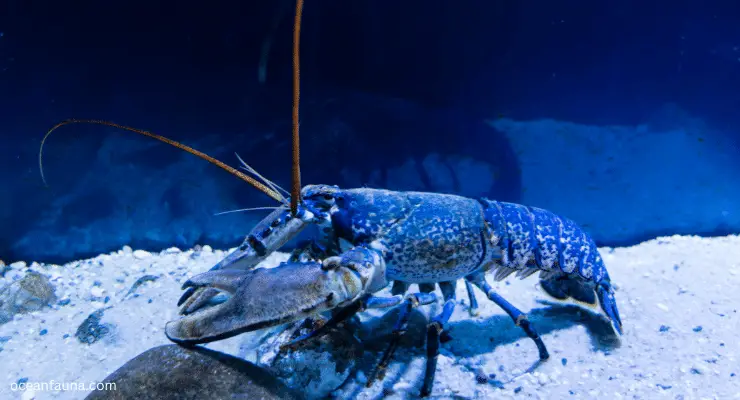
Lobsters are classified under the family Nephropidae and the Palinuridae.
- Nephropidae (True Lobsters)
- These are the lobsters with claws.
- Genus: Homarus (Example: Homarus americanus, the American lobster)
- Genus: Nephrops (Example: Nephrops norvegicus, the Norway lobster)
- Palinuridae (Spiny Lobsters):
- These are the lobsters without claws.
- Genus: Panulirus (Example: Panulirus argus, the Caribbean spiny lobster)
- Genus: Jasus (Example: Jasus lalandii, the Cape lobster)
There are other families, too, like the Synaxidae (slipper lobsters) and Polychelidae (deep-sea lobsters). They fall under the order Decapoda. ~Source
Crayfish
Crayfish are freshwater crustaceans resembling small lobsters. They are also known as crawfish, crawdads, or freshwater lobsters and belong to three families:
- Astacidae: European crayfish, like the noble crayfish (Astacus astacus)
- Cambaridae: North American crayfish, which includes numerous genera such as:
- Cambarus (Example: Cambarus bartonii, the common crayfish)
- Procambarus (Example: Procambarus clarkii, the red swamp crayfish)
- Parastacidae: Includes Tasmanian giant freshwater crayfish (Astacopsis gouldi), which is the earth’s biggest freshwater invertebrate.
There are over 600 known crayfish species, with Procambarus clarkii and Orconectes virilis being two commonly recognized ones. ~Source
| Taxonomy | Lobster | Crayfish |
| Kingdom | Animalia | Animalia |
| Phylum | Arthropoda | Arthropoda |
| Class | Malacostraca | Malacostraca |
| Order | Decapoda | Decapoda |
| Infraorder | Astacidea (clawed lobsters); Achelata (clawless lobsters) | Astacidea |
| Family | Nephropidae, Palinuridae, Scyllaridae, Synaxidae | Astacidae/Cambaridae/Parastacidae |
| Species | 75 | Over 600 |
2. Habitat and Distribution
Lobsters and crayfish may be related. Still, their preferences differ quite a bit regarding their habitat.
Lobster
Lobsters are marine crustaceans that can be found in oceans all around the world. Here’s a breakdown of where different types of lobsters live:
- American Lobster: Inhabited the North Atlantic Ocean, ranging from Labrador in the north to North Carolina in the south.
- European Lobster: Resident of the eastern Atlantic Ocean, ranging from the Arctic to the northern Mediterranean Sea and parts of the Black Sea.
- Spiny Lobsters: Inhabit tropical and subtropical waters in the Atlantic, Pacific, and Indian Oceans. They’re commonly found in warm water regions like the Caribbean, Florida, and Australia.
- Slipper Lobsters: These are found in various oceans worldwide, predominantly in warmer waters.
- Reef Lobsters (Enoplometopus species): Typically found in the tropical Indo-Pacific region, living in coral reef habitats.
- Deep Sea Lobsters: Adapted to life in the deep sea, far from the continental shelves.
In terms of habitat, lobsters generally prefer rocky, sandy, or muddy bottoms where they can hide from predators. They are often found in crevices or burrows. They can inhabit a range of depths, from shallow coastal waters to deeper parts of the ocean. However, the specific preferred depth can vary by species. ~FAO
Crayfish
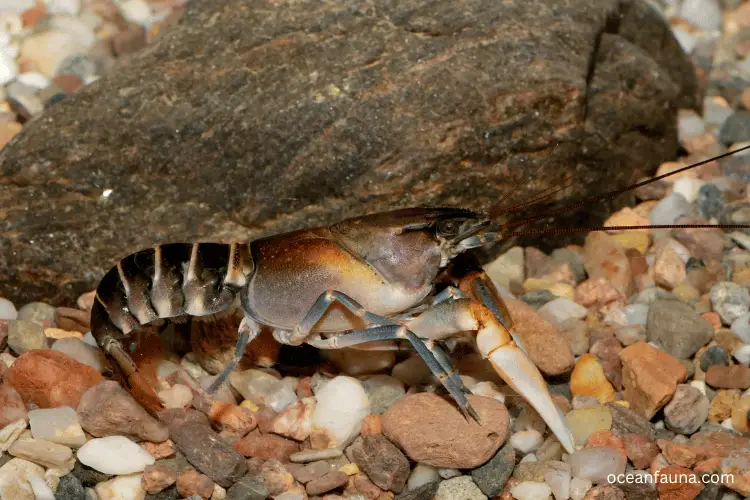
Unlike their salt-loving cousins, crayfish are purely freshwater inhabitants. You won’t find them in the oceans. Instead, they dominate freshwater ecosystems such as rivers, lakes, ponds, and wetlands.
Also Read: Shrimp Vs Lobster: What are the Differences?
Crayfish are burrowers. Using their strong, chelated limbs, they create burrows in the muddy or sandy substrate, which they use as shelters, nesting sites, and sometimes as hideouts from predators.
They have a more cosmopolitan distribution than lobsters, as explained in the journal Proceedings of the Indiana Academy of Science. They’re found on every continent but Africa and Antarctica. North America is a hotspot for crayfish diversity, with the southeastern United States boasting a particularly high number of species.
| Criteria | Lobster | Crayfish |
| Primary Habitat | Marine (Oceans) | Freshwater (Lakes, rivers, ponds) |
| Substrate Preference | Sandy or rocky bottoms | Muddy or sandy bottoms, often with vegetation |
| Geographical Distribution | Mostly Atlantic Ocean, specific to species | Worldwide (except Africa & Antarctica), dominant in North America |
3. Physical Appearance
Lobsters and crayfish have a few striking physical differences and a couple of similarities.
Lobster
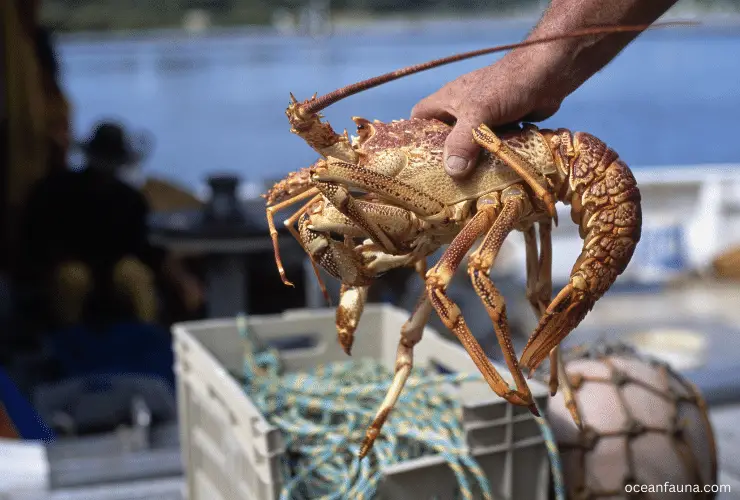
- Size: Lobsters can get impressively big, especially when compared to crayfish. A mature American lobster can measure 8 to 24 inches long, though some record-holders have been even larger.
- Body Shape: They usually have a long, cylindrical body with a robust carapace. They have a distinct rostrum (a protruding section) at the front of their head.
- Claws: The first pair of their walking legs are modified into large, strong claws. One is sharp and thin (used as a cutter), and the other is broader and powerful (used for crushing).
- Color: They are usually greenish-brown or blue-black in their natural habitat. The iconic red hue most of us associate with lobsters only comes out after they’re cooked.
- Tail: Lobsters have a broader, more muscular tail. This tail helps in locomotion, allowing them to swim backward rapidly by flexing it.
- Antennae: They have two pairs of antennae. The longer pair is prominent and can be as long as the body in some species. ~American Oceans
Crayfish
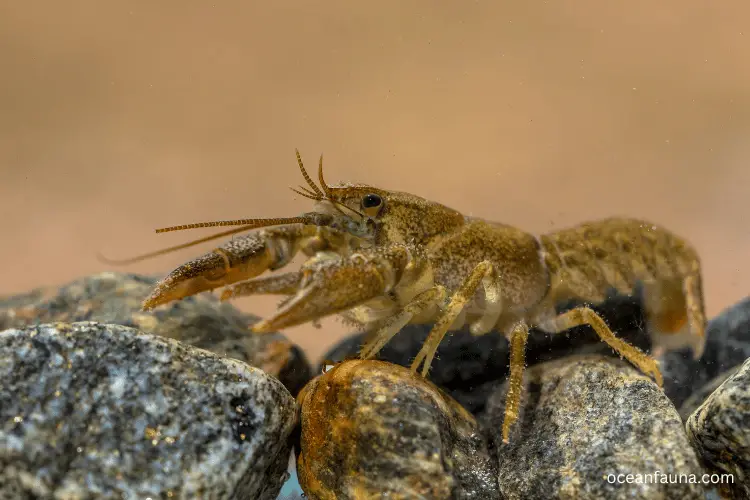
- Size: Crayfish are smaller, typically measuring 3 to 6 inches long.
- Body Shape: They have a more compact body, and while they also have a rostrum, it’s generally less pronounced than in lobsters.
- Claws: Like lobsters, crayfish have claws (or chelae) on their first pair of walking legs, but they’re much smaller than their body size. The claws are used for defense, feeding, and digging.
- Tail: Their tails are less muscular compared to lobsters. They can still flex them for a quick backward movement, but it’s not as powerful.
- Color: While many crayfish sport a brown or muddy color, certain species can dazzle with blues, reds, and even whites.
- Antennae: Crayfish also have two pairs of antennae, but they are generally shorter than those of lobsters. ~Source
| Feature | Lobster | Crayfish |
| Size | 8 to 24 inches (can be larger) | 3 to 6 inches |
| Color | Greenish-brown or blue-black (red when cooked) | Brown, blue, red, etc. (varies by species) |
| Claws | Two large, unequal-sized claws | Smaller claws in proportion |
| Body Shape | Longer, with a distinct carapace and abdomen | More compact, with a similar division between carapace and abdomen |
| Antennae | Two long primary antennae | Two shorter primary antennae |
| Claws | Two large claws: one for crushing & one for cutting | Two claws, but smaller than a lobster’s |
| Tail | Muscular | Less muscular |
| Number of legs | 10 (including claws) | 10 (including claws) |
4. Diet and Feeding Habits
While from different habitats, lobsters and crayfish have evolved similar feeding habits to sustain and thrive in their respective environments.
Lobster
Lobsters typically roam the ocean floor, scavenging for food. A lot of lobsters’ diet comprises live prey, especially in their younger, more active years. They like
- Small fish
- Mollusks, including clams, mussels
- Worms
- Crabs
- Sea urchins
- Some aquatic insects.
They also consume algae and seaweed. This is particularly common when other food sources are scarce. Their large claws are perfect for snatching and crushing prey.
Here’s an odd fact – lobsters might eat their molted shell! This act of apparent cannibalism is beneficial because it allows them to reclaim lost calcium and phosphorus. ~NOAA Fisheries
Crayfish
Crayfish are bottom dwellers, scavenging and foraging along riverbeds, pond bottoms, and lakes. They are fans of
- Aquatic plants,
- Algae,
- Insects,
- Tadpoles,
- Small fish.
A big portion of a crayfish’s diet is detritus – decaying plants and animals. This makes them vital for nutrient recycling in freshwater habitats. ~Source
| Dietary Aspect | Lobster | Crayfish |
| Animal-Based Diet | Small fish, mollusks, crustaceans, worms | Insects, tadpoles, small fish, and other crayfish occasionally |
| Plant-Based Diet | Algae, seaweed | Aquatic plants, algae |
| Scavenger Diet | Dead organisms and occasional molted shell | Detritus (decaying plants and animals) |
5. Social Behavior
Both crustaceans also have their unique quirks and behaviors.
Lobster
Lobsters are generally solitary animals. They don’t form groups or clusters but instead navigate the ocean floor independently.
They are quite territorial and defend their home territories fiercely, often using their strong claws to ward off intruders.
Lobsters have unique mating behavior. The female chooses a mate and then sheds her shell, making herself vulnerable. This act requires a lot of trust, as the male protects her until her new shell hardens.
They communicate using pheromones in their urine. However, confrontations between two lobsters can lead to aggressive displays and even physical combat. ~Source
Crayfish
Crayfish are generally more social than lobsters. While they do have their solitary moments, crayfish are known to form loose groups, especially in environments rich in resources.
They are also territorial. They defend their homes vigorously, often raising their claws in a threat display.
These crustaceans communicate using a blend of body postures, movements, and even chemical signals (pheromones). These methods can signal aggression, submission, and even readiness to mate.
A social hierarchy is evident in some crayfish populations. Dominant individuals often have prime access to resources like food and the best shelters, as discussed in an article published in the Journal of Experimental Biology.
| Behavior | Lobster | Crayfish |
| Social Nature | Solitary | Semi-social (often solitary but can form loose groups) |
| Territoriality | Highly territorial | Territorial, especially over burrows |
| Communication | Movements, dance | Body postures, movements, pheromones |
| Hierarchy | Not strongly hierarchical | Some species show clear dominance hierarchies |
| Mating Behavior | Female sheds her shell, and the male protects her | Varies by species, and often involves complex signaling |
6. Reproduction and Lifecycle
Both lobsters and crayfish have captivating reproductive strategies.
Lobster
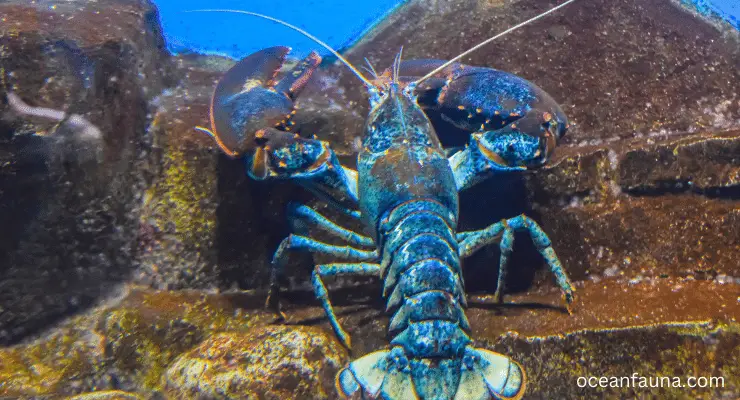
- Courtship: During courtship,the female lobster releases a pheromone to signal her intent, making her approach. At the same time, the male lobster wafts the scent towards himself with his swimmerets.
- Mating: After the initial courtship, the female lobster molts, shedding her exoskeleton to mate. During this vulnerable period, the male protects her. She stores his sperm to fertilize her eggs at a later time.
- Egg-Bearing Females: Once fertilized, the female carries her eggs underneath her abdomen. She could bear anywhere from several thousand to over 100,000 eggs depending on the species and the lobster’s age. These eggs can take up to a year to hatch.
- The Larval Stages: After hatching, lobsters go through several larval stages, drifting as zooplankton before settling to the ocean floor and metamorphosing into a form that begins to resemble an adult lobster.
- Lifespan: On average, male lobsters have a lifespan of 31 years, while females live up to 54 years. However, some females may live up to 72 years. ~The University of Marine
Crayfish
- Courtship: Crayfish courtship is less about dance and more about touch. The male gently touches the female with his claws and antennae, coaxing her into a receptive posture for mating.
- Mating: In crayfish mating, the male deposits a sperm packet directly into the female’s seminal receptacle.
- Egg-Bearing Females: Post-fertilization, the female attaches her eggs to the swimmerets underneath her tail, where they remain until they hatch. A female crayfish can carry 400 to thousand eggs.
- The Larval Stages: After hatching, crayfish undergo a series of molts as they grow. They don’t have a free-floating larval stage like lobsters. Instead, they resemble miniature adults from the start, growing in size and maturity with each molt.
- Lifespan: Crayfish lifespans vary widely. Some types live for just two years, while others, like the signal crayfish, can live up to 20 years. ~Source
| Reproduction | Lobster | Crayfish |
| Courtship | Release pheromone | Touch with claws and antennae |
| Mating | Female molts, the male protects, indirect fertilization | Direct sperm deposit |
| Egg Carrying | Under the abdomen, thousands to over 100,000 eggs | Under the tail, 400-1000 eggs |
| Development | Several larval stages, free-floating | Directly resemble mini-adults, no larval stage |
| Lifespan | Males: 31; Females: 54 years | 2-20 years |
7. Natural Predators
Both lobsters and crayfish face their share of challenges from other creatures looking for a meal.
Lobster
With their armored exoskeletons, lobsters might appear well-protected, but they’re not undefeatable. They are eaten by
- Large fish, such as cod, conger eels, haddock, dogfish, flounder, and grouper
- Seals, particularly harbor seals
- Octopus
Crayfish
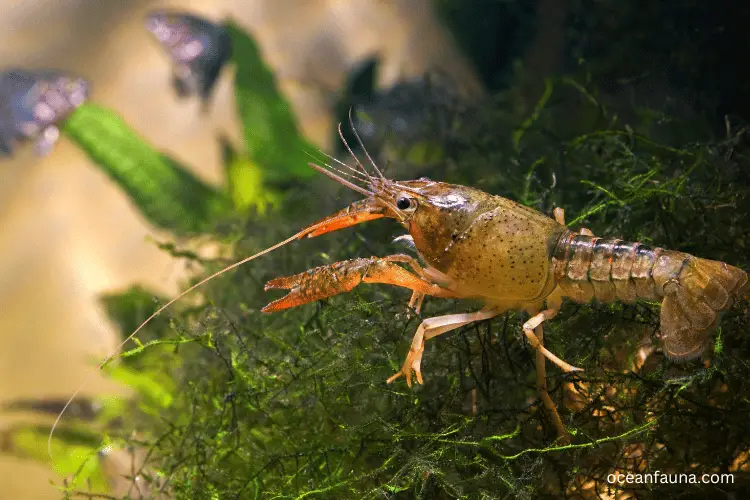
In freshwater habitats, crayfish have their own set of predators to be wary of. These include
- Large fish, like bass, walleye, and catfish
- Frogs and tadpoles, particularly the larger species
- Birds, such as herons, egrets, and kingfishers
- River otters
| Natural Predator | Lobster | Crayfish |
| Large Fish | Cod, haddock, flounder, grouper | Bass, walleye, catfish |
| Mammals | Seals (especially harbor seals) | River otters |
| Other | Octopus | Frogs, tadpoles |
| Birds | Rarely | Herons, egrets, kingfishers |
8. Defense Mechanism
Both lobsters and crayfish have evolved fascinating mechanisms to defend themselves from threats.
Lobster
Lobsters rely on a blend of physical and behavioral strategies to keep themselves safe.
- The most iconic feature of a lobster is its large claws. The bigger one, the crusher claw, is powerful and can deliver a serious pinch, dissuading potential predators. The other, the cutter or pincher claw, is used for tearing food.
- Despite their tough exterior, lobsters often choose flight over fight. When threatened, they use their strong abdomen muscles to propel themselves backward in a rapid escape maneuver.
- These marine crustaceans are nocturnal and spend their days hiding under rocks or in crevices. This natural behavior keeps them safe from many daytime predators.
- Depending on the species and environment, lobsters can have colorations that allow them to blend into their surroundings, providing additional protection.
Crayfish
Crayfish have developed their own set of defensive tactics.
- Much like lobsters, crayfish possess strong claws that they use both for foraging and defense. A crayfish often adopts a raised posture, claws wide open, to warn or fend off potential threats.
- When faced with danger, crayfish can quickly dart backward using a flick of their tail, just like lobsters.
- Many crayfish species are adept at digging and will create burrows in the substrate. These burrows provide both shelter and a place of retreat when predators are nearby.
- A unique behavior observed in some crayfish when threatened is the “tail-flip” response. When a predator gets too close, the crayfish can use its tail to create a sudden burst of speed, flipping its body and escaping the immediate threat.
| Defense | Lobster | Crayfish |
| Claws | Crusher and cutter claws for pinching and tearing | Strong claws for warning and defense |
| Escape Movement | Swift backward propulsion with the abdomen | Quick backward dart and tail-flip response |
| Hiding Behavior | Nocturnal, hides under rocks during the day | Creates burrows in the substrate |
| Camouflage | Colorations to blend in with the seabed | Some species can blend with freshwater environments |
9. Interaction With Humans
Both lobsters and crayfish have had a unique and extensive relationship with humans.
Lobster
In past centuries, especially in North America, lobsters were so plentiful that they were seen as food for the poor or even used as prison food. It’s only in more recent times, with the rise of gourmet cooking and marketing, that they’ve become the luxury item they are today.
In regions such as Maine, USA, and Atlantic Canada, lobster fishing is a major industry, contributing significantly to the local economies.
Lobster fishing isn’t just a commercial endeavor. In places like California, sport or recreational lobster fishing is a popular activity, albeit with regulations to ensure sustainability.
Beyond the dinner plate, lobsters are also kept in public aquariums, showcasing their behaviors and ecological roles to the general public. ~Spoon University
Crayfish
Though not as globally recognized as lobsters, crayfish have their own kind of interaction with humans.
In places like Louisiana, USA, crayfish (or crawfish,” as they’re locally called) is a cultural and culinary staple. A traditional crawfish boil is a community event filled with fun, music, and delicious crawfish.
Crayfish are commonly used as bait in freshwater fishing, especially for game fish like bass.
The smaller size and diverse colorations of some crayfish species make them popular in-home aquariums. They are often kept for their interesting behaviors and their role in maintaining a clean tank environment.
Crayfish are often studied by scientists as an indicator species, as described in an article published by the Cambridge University Press. Their presence, abundance, and health can provide clues about the quality of freshwater habitats.
| Human Interactions | Lobster | Crayfish |
| Culinary Use | Luxury item in gourmet cooking | Local delicacies, especially in Southern USA |
| Economic Importance | Major industry in regions like Maine and Atlantic Canada | Significant in regions with crayfish fisheries like Louisiana |
| Aquarium Presence | Public aquariums | Both public and home aquariums |
10. Threats and Conservation Status
Lobsters and crayfish face both natural and human-induced threats.
Lobster
Lobsters face many threats. These include:
- Overfishing
- Climate change
- Increasing ocean acidity
In recent years, shell disease, a condition that causes the lobster’s shell to degrade, has been on the rise, especially in waters that are warmer than their historical averages.
Crayfish
Crayfish too face significant threats.
- Habitat Loss
- Pollution from agricultural runoff, industrial discharges, and untreated sewage
Non-native crayfish species, introduced either accidentally or intentionally, can outcompete or bring diseases to native crayfish populations, leading to declines.
| Species | Threats |
| Lobster | Overfishing, Climate Change, Disease |
| Crayfish | Habitat Loss, Invasive Species, Pollution |
Wrapping Up
So, are Lobster and Crayfish the same? Certainly not! They both come from the crustacean family but are very different in their habitats, diets, and adaptations.
Lobsters are generally larger and more robust than crayfish. They predominantly live in the vast oceans, while crayfish reside in freshwater habitats like rivers and lakes. The natural coloration of the two differs, with lobsters generally having muted colors and crayfish showcasing a variety of hues.
We hope this read has sprinkled a bit more wonder and curiosity about the amazing creatures in our big, beautiful world. Dive right back at any time for more informative comparisons!

